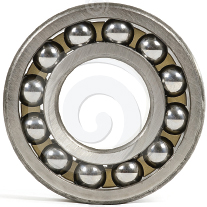EXAMPLE 3Measuring Metal Loss in a Mechanical Process
A spherical bearing has a radius of 3cm when it is new. Use differentials to approximate the volume of the metal lost after the bearing wears down to a radius of 2.971cm. Compare the approximation to the actual volume lost.

Solution The volume V of a sphere of radius R is V=43πR3. As a machine operates, friction wears away part of the bearing. The exact volume of metal lost equals the change ΔV in the volume V of the sphere, when the change in the radius of the bearing is ΔR=2.971−3=−0.029cm. Since the change ΔR is small, we use the differential dV to approximate the change ΔV. Then ΔV≈dV=↑dV=V′dR4πR2dR=↑dR=ΔR(4π)(32)(−0.029)≈−3.280
The approximate loss in volume of the bearing is 3.28cm3.
234
The actual loss in volume ΔV is ΔV=V(R+ΔR)−V(R)=43π⋅2.9713−43π⋅33=43π(−0.7755)=−3.248cm3
The approximate change in volume is correct to one decimal place.